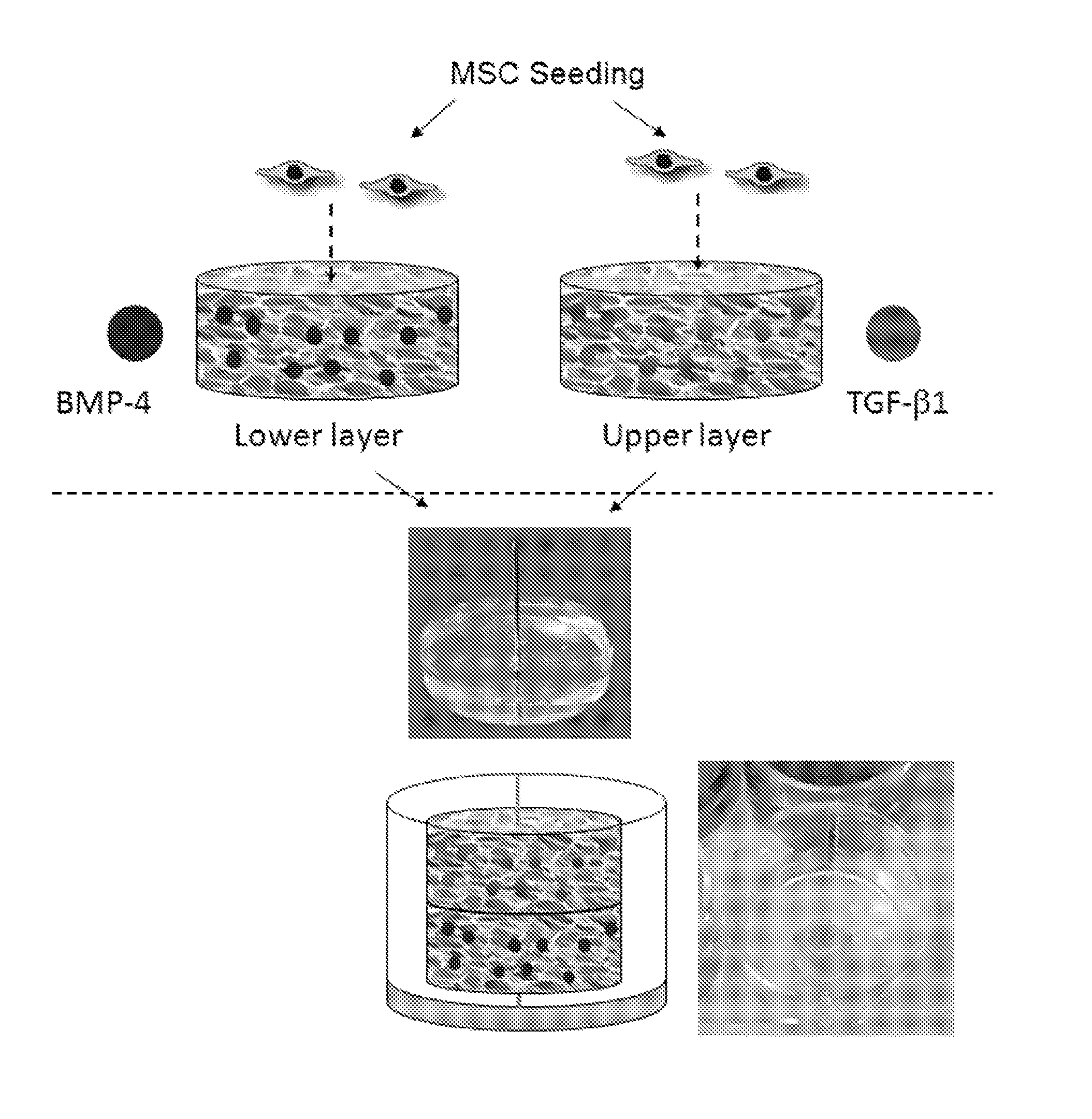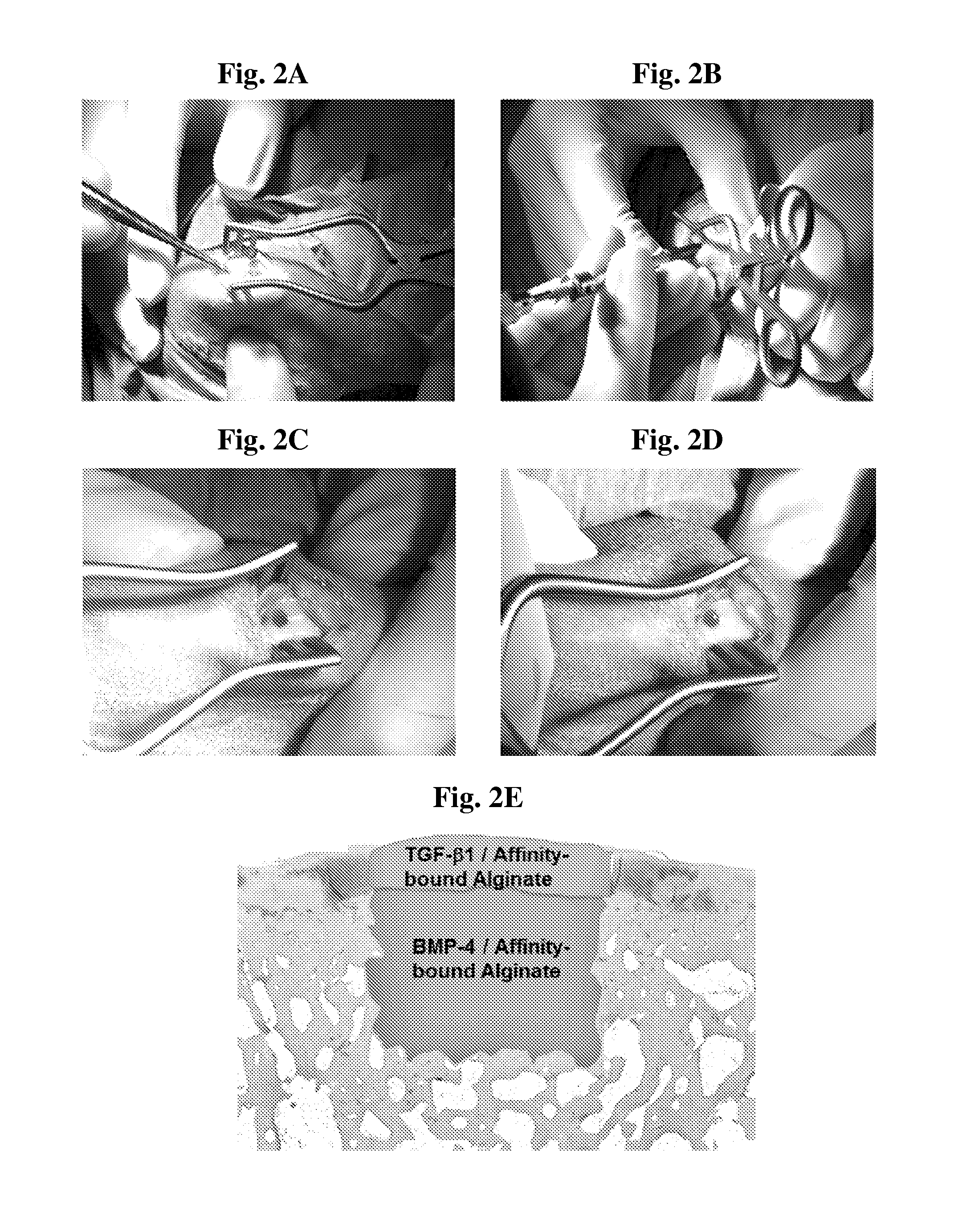Hydrogel system comprising spatially separated bioactive polypeptides
a bioactive polypeptide and hydrogel technology, applied in the direction of peptide/protein ingredients, prosthesis, osteogenic factor, etc., can solve the problems of crucial barriers and chronic disabilities
- Summary
- Abstract
- Description
- Claims
- Application Information
AI Technical Summary
Benefits of technology
Problems solved by technology
Method used
Image
Examples
example 1
BMP-4 Binding and Activity
[0095]To validate BMP-4 binding to alginate-sulfate, SPR analysis was performed, revealing a strong and specific binding of BMP-4 to alginate-sulfate (KA=5.63×109 M−1). The affinity binding of BMP-4 to alginate-sulfate / alginate scaffold enabled its protection during fabrication; the total amount of loaded BMP-4, determined by ELISA, was 1.5-times greater in the affinity-bound scaffolds than in scaffolds with no alginate-sulfate (59.37±1.34 ng vs. 39.49±2.6 ng in the control, (p<0.05)).
[0096]To ensure BMP-4 bioactivity, monolayers of rat cardio-fibroblasts were treated with the released medium from BMP-4 / affinity binding scaffolds. The released medium, collected at day 1 of the release study, was diluted to a BMP-4 concentration of 9 ng / mL, and BMP-4 bioactivity was assessed by its ability to enhance collagen production in these cultures (FIG. 3). Collagen deposition was significantly greater in the cultures exposed for 3 days to medium collected from BMP-4 / ...
example 2
BMP-4-Induced MAPK Signaling Pathway in hMSC Cultures
[0097]BMP-4 activation of MAPK signal-transduction pathway, known to be involved in hMSC osteogenic differentiation (Levy O. et al., 2010, Kozawa O. et al., 2002) was evaluated by Western blot analysis in hMSC constructs (FIG. 4A). The ERK1 / 2 phosphorylation levels were significantly greater (p<0.05) in the BMP-4 / affinity-bound constructs than in control constructs on days 7 and 14, indicating the long-term bioactivity of the locally presented BMP-4 in these scaffolds (FIG. 4B). In cell constructs with no BMP-4 supplementation, the activation of ERK1 / 2 was significantly lower (p<0.05).
example 3
BMP-4-Induced Osteogenic Differentiation in hMSC Construct
[0098]The osteogenic differentiation of hMSCs within BMP-4 / affinity-bound scaffold was evaluated by measuring the alkaline phosphatase (ALP) activity, a known marker for osteogenic differentiation (Qi H. et al., 2003) (FIG. 5A), and by following the deposition of mineralized bone matrix (FIG. 5B). Significantly greater ALP activity levels were detected after 3 weeks of cultivation in BMP-4 / affinity-bound scaffolds, compared to the levels in BMP-4 / adsorbed (alginate) scaffolds (p<0.05). Additionally, von Kossa staining indicated the presence of massive mineralized bone matrix deposition in the BMP-4 / affinity-bound scaffold, after 3 weeks (FIG. 5B). Of note, the DNA content, determined by Hoechst assay, was similar in all constructs (data not shown), indicating that the greater deposition of mineralized bone matrix in the affinity-binding constructs is due to the sustained presentation of BMP-4 and its prolonged activity as an ...
PUM
| Property | Measurement | Unit |
|---|---|---|
| Force | aaaaa | aaaaa |
| Interaction | aaaaa | aaaaa |
| Electrostatic interaction | aaaaa | aaaaa |
Abstract
Description
Claims
Application Information
 Login to View More
Login to View More - R&D
- Intellectual Property
- Life Sciences
- Materials
- Tech Scout
- Unparalleled Data Quality
- Higher Quality Content
- 60% Fewer Hallucinations
Browse by: Latest US Patents, China's latest patents, Technical Efficacy Thesaurus, Application Domain, Technology Topic, Popular Technical Reports.
© 2025 PatSnap. All rights reserved.Legal|Privacy policy|Modern Slavery Act Transparency Statement|Sitemap|About US| Contact US: help@patsnap.com



